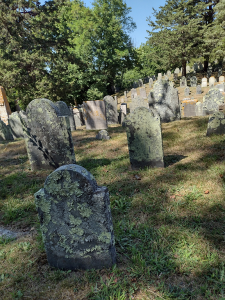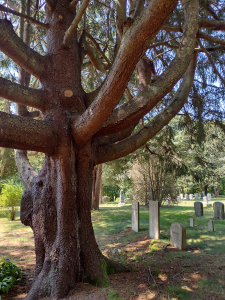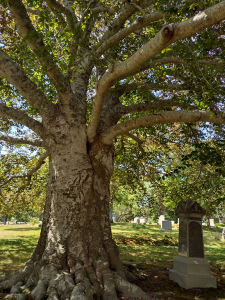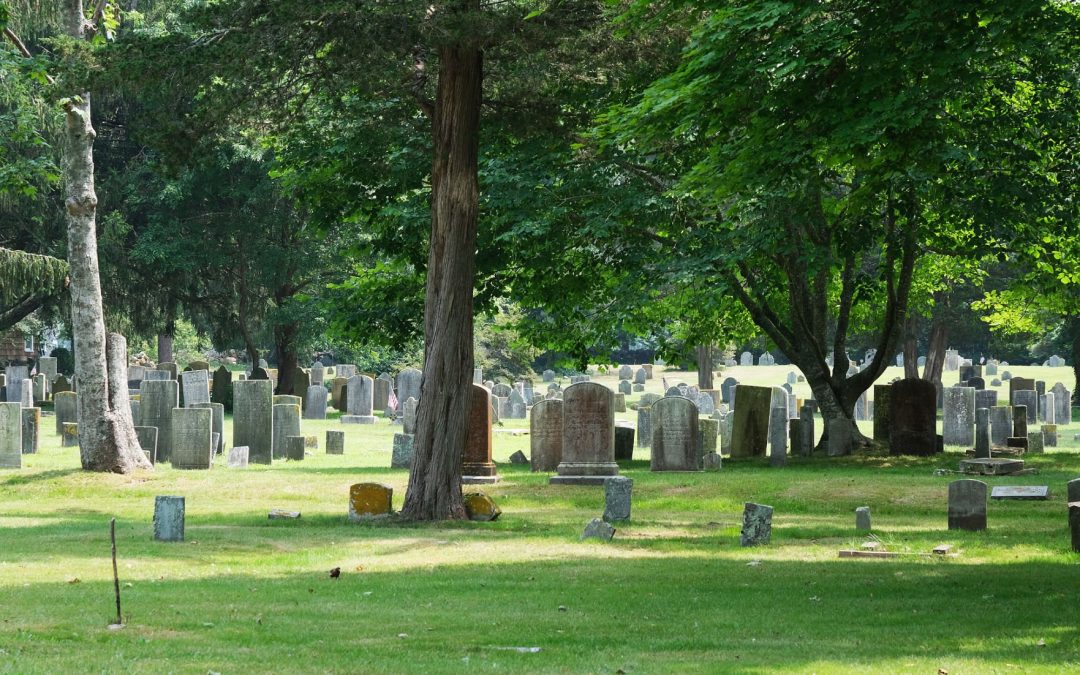Reflect presumptuous men: how short thy space
How few thy moments and how quick they fly
– Nantucket headstone
BY BARBARA CLARK
The idea of strolling through an old burial ground on an afternoon, soaking up its ambiance, reading its epitaphs and enjoying the quiet of nature might seem like a nonstarter for some folks. For other curious travelers, though, there’s a sense of history to be found in these intriguing spots, along with the attraction of looking more closely at how history has unfolded around us. David Martin, former president of the Marstons Mills Historical Society, said that reading a cemetery’s small histories inscribed in stone “helps keep our awareness of history alive.”
How about, for many of us outdoor wanderers and seekers of stories, they’re just plain fascinating places to spend time! These old burial grounds are alive with history and intriguing stories, engaging us from a quiet place in nature.
STORIES IN STONE
 The Cape is home to more than 135 cemeteries of varying sizes and shapes, with thousands of individual burial sites across 15 towns in Barnstable County. These range from old, historic burial grounds, with their lichen- and moss-covered stones, to more-contemporary memorial parks. Add to these the Massachusetts National Cemetery in Bourne, with more than 78,000 burials of veterans and their families. The Cape’s burial spots draw families, storytellers, writers, ghost hunters and historians…along with those seeking a quiet open space and a look back into our fascinating past.
The Cape is home to more than 135 cemeteries of varying sizes and shapes, with thousands of individual burial sites across 15 towns in Barnstable County. These range from old, historic burial grounds, with their lichen- and moss-covered stones, to more-contemporary memorial parks. Add to these the Massachusetts National Cemetery in Bourne, with more than 78,000 burials of veterans and their families. The Cape’s burial spots draw families, storytellers, writers, ghost hunters and historians…along with those seeking a quiet open space and a look back into our fascinating past.
Today Cape Cod has a number of newer memorial parks, often containing columbaria that hold cremated remains, and now there are online obituaries and funeral home legacy pages with biographies and eulogies for the departed.
In a pleasant contrast, the Cape’s old burial grounds function like an open history book, full of stories and inscriptions that can be both droll and poignant. Each find is a unique diary of eulogy, advice and often a moral comment or two, reflecting on the lessons of life and death. Many are embellished with carvings of angels or skulls, winged effigies or entwined vines, created by both homegrown and professional gravestone carvers.
Who’s Where? A Walk along Cape Cod’s Cemetery Pathways
At least 36 sea captains and mariners are interred or memorialized at the Universalist Cemetery, scattered among the more than 350 gravestones tucked in back of the Federated Church in Hyannis. Many of these date back to the 1800s, when the village of Hyannis was a thriving maritime port.
 Near the front portion of the cemetery there’s a marble obelisk with a carving of a beautiful schooner under full sail. Many sailors died while away at sea, and this striking cenotaph (so-called when no human remains are buried there) honors young Horatio S. Simmons, who was “born Dec. 27 1835; died at sea May 17 1855, aged 19 ys 4 mos 20 ds.” His epitaph tells a tantalizing snippet of the story: “d. onboard ship Bay State & buried at sea off Cape Horn.”
Near the front portion of the cemetery there’s a marble obelisk with a carving of a beautiful schooner under full sail. Many sailors died while away at sea, and this striking cenotaph (so-called when no human remains are buried there) honors young Horatio S. Simmons, who was “born Dec. 27 1835; died at sea May 17 1855, aged 19 ys 4 mos 20 ds.” His epitaph tells a tantalizing snippet of the story: “d. onboard ship Bay State & buried at sea off Cape Horn.”
Mariners have also found resting places at Lothrop Hill Cemetery in Barnstable. Seafarer Samuel Hinckley’s gravestone is headed by a carved angel trumpeting the news, “Arise th’ dead.” Captain Hinckley’s satisfaction at being able to rest in the ground back in Barnstable, home from the sea, reads on his stone: “Long did my native powers/The dangerous ocean brave/Protected by my God/At home I make my grave.”
Cape Cod’s burial grounds have their own unique personalities. Lothrop Hill contains a trove of old gravestones, including the oldest stone on Cape Cod. Dated 1683—closing in on 250 years—it memorializes one Hope Chipman, and her early slate tablet joins five others found at Lothrop Hill that date to the 1600s.
The hilly, picturesque gravesites at Cobb Hill Cemetery (also Cobb’s Hill), just above Barnstable Village and behind its Unitarian Church, contain the graves of a number of the early settlers of Barnstable. The area has long attracted historians and ghost hunters, and “haunted history” tours are held regularly in the village and at this cemetery, taking in other nearby buildings such as the Old Jail across the way.
At Marstons Mills Cemetery on Route 149, visitors can stand under the spreading branches of a magnificent Norway spruce to view the resting places of the village’s early settlers. In 2020, the gravesites of a dozen local soldiers who served in America’s Revolutionary War were restored and specially designated during a public ceremony at the cemetery.
David Schafer, president of the Cape Cod Chapter, Sons of the American Revolution, said a “reasonable estimate” is that close to 1,500 patriots of that war who served with Cape Cod militias are buried in local cemeteries. He added that improved research methods are likely to increase that number in future years.
A Country Meadow, A Weeping Beech
One writer has described the Old Burying Ground in Falmouth as resembling “a country meadow.” Falmouth’s famous citizen Katharine Lee Bates played in this lovely spot as a child, perhaps near the stately line of sycamore maples that still stand at the edge of the old cart path.
This quiet, four-acre Falmouth landscape contains more than 700 graves. American Revolution patriot Major Joseph Dimmick (1734-1822), whose grave lies here, was in charge of the Falmouth militia, which trained weekly on the Falmouth Village Green. He and his brother Lot were often out at sea, intercepting British privateers that entered local waters, and his militia defended the village of Falmouth at Surf Drive in April 1779 against a British fleet offshore. Markers indicate burial spots for 56 such Revolutionary War veterans, in addition to a number from the Civil War and the War of 1812.
A champion purple weeping beech tree holds center stage at the Oak Grove Cemetery on Sea Street in Hyannis. Local historians estimate that the tree is close to 250 years old. Its towering branches seem to anchor the 15-acre grounds, welcoming walkers on quiet paths among the more-than-2,600 gravesites, monuments and crypts, many populated by noted founding families of the area, such as Hallett, Crowell, Scudder, Bearse and Marston.
Epitaphs Note The Notables And The Just Plain Folks
 The hundreds of epitaphs on Cape Cod’s burial stones share history at the personal scale. Just read the stones: the folks who lie here taught school, tended cranberry bogs and practiced law, or became homesteaders, farmers, postmasters or preachers. Some of the more adventurous joined the westward trek or tried their luck in the Gold Rush.
The hundreds of epitaphs on Cape Cod’s burial stones share history at the personal scale. Just read the stones: the folks who lie here taught school, tended cranberry bogs and practiced law, or became homesteaders, farmers, postmasters or preachers. Some of the more adventurous joined the westward trek or tried their luck in the Gold Rush.
These stories echo a simpler time of belief and practicality, and often their individual achievements fund the imagination. Daniel Snow Hallett (1852, Universalist Cemetery), was the first lighthouse keeper in Hyannis. He successfully petitioned Congress to establish the South Hyannis Light in Hyannis Harbor. Decommissioned in 1929 and now privately owned, it still stands at the end of Harbor Road, visible to sailors entering Lewis Bay waters.
The gravesite of Captain John “Mad Jack” Percival (1862) remains prominent at Old West Barnstable Cemetery, off Route 6A. Known for his sometimes irascible temperament, Percival was a celebrated officer in the US Navy who late in his career (1844-45) circumnavigated the globe as captain of the refurbished, world-famous frigate USS Constitution (Old Ironsides), against all expectations for either Percival or the aging wooden warship.
James Otis (1778), who lies in Old West Barnstable Cemetery, was the father of famed Revolutionary War patriots and Cape Cod noteworthies James Otis Jr. and his sister, Mercy Otis Warren. Part of his intriguing epitaph reads: “Farewell hope of fortune, you have deceived me enough/Now mock others.” Still another portion of his epitaph foretells “a happy eternity.”
Epitaphs frequently advise us that we’re all made equal by death. The Reverend Samuel Palmer’s epitaph (1775) at the Old Burying Ground reads in part: “His virtues would a monument supply/But underneath these clods his ashes lie.”
Epitaphs bestow honor and recognition as well: at Marstons Mills Cemetery, Ebenezer Crocker (1817) was deemed “long an able, upright, efficient & useful citizen,” while Judge Nymphas Marston (1864) was a “Protector of the Widow and Orphan” and was “richly furnished for all the contests of the Bar.”
Underlying all was the inevitable memento mori on nearly all tombstones, describing an era when death was a common companion. There were countless variations on the theme: “As I am now/So you shall be/Prepare for death and follow me.”
With this focus on old burials and earlier times, it can be easy to forget more-contemporary memorials that have captured the imagination. One of the most-poignant remembers The Lady of the Dunes, whose grave lies in St. Peter’s Cemetery in Provincetown. A young woman was murdered in the dunes off Race Point in 1974, and her identity was unknown for nearly five decades. An anonymous grave marker named her “The Lady of the Dunes,” and visitors often came to leave small mementos at her gravesite. In 2022, after many years, she was finally identified, and now Ruth Marie Terry has a new marker, with dates and a photo, added by her family members. The gravesite has been visited frequently over the years, and now Ruth Marie is honored with her real name.
RESTORATION
Many cemeteries across the Cape have sought funding to preserve and restore their old gravestones. One example has been the ongoing restoration underway at the Universalist Cemetery in Hyannis. Efforts began nearly a decade ago when church member Pamela Brown began researching restoration options. Community Preservation Funds awarded to the church began the conservation efforts at the oneacre graveyard, where more than 270 stones have needed restoration work.
A walk there today reveals the painstaking work already underway. Jonathan Appell of Atlas Preservation in Southington, Connecticut, started work this spring and hopes to finish by year’s end. Careful research is done on each gravesite, where “the geology of each stone is crucial,” Appell said. The rows of refurbished stones now stand like upright sentinels, their foundations and bases now uncovered and their granite, marble and slate tablets now firmly fixed on the base. The surfaces of many stones were sunk as much as two feet below the surface, and many monuments had to be raised and stabilized with quantities of sand and gravel. Broken tablets have been rejoined and raised to their original height, with lost inscriptions brought to light, glowing with rediscovered stories.
Appell spent much of last year on a 48-state tour, driving to communities across the country and offering free preservation workshops helping educate people on ways to preserve their community treasures.

